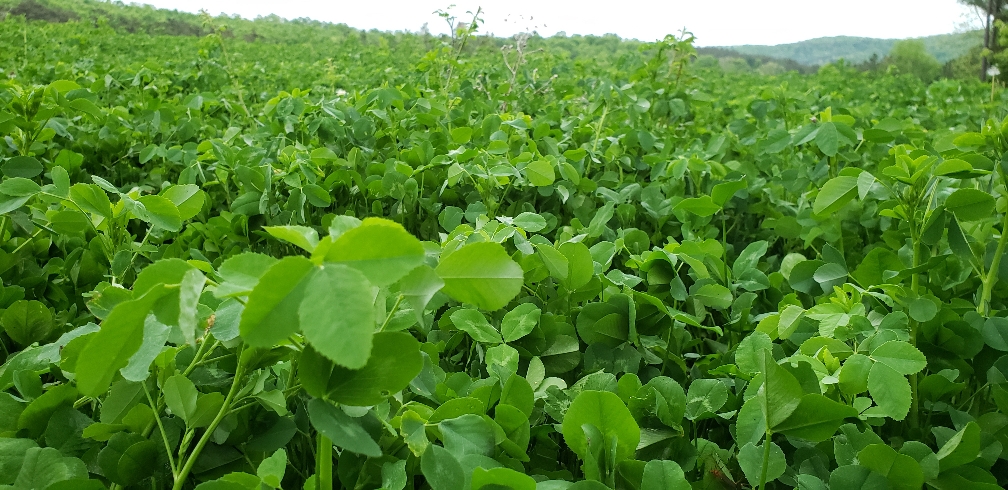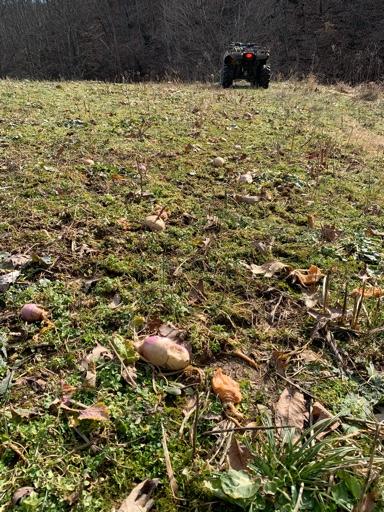Mennoniteman
Well-Known Member
This past Saturday I threw a 200 gallon tote of water on the back of my truck and sprayed some of my small clover plots for weeds. This is probably the most important thing that I do all year for these plots, in fact, it may be the only thing I do all year for some of these plots. A food plot doesn't need to be perfect to attract and feed deer, but if someone has a hankering for a picture perfect clover plot year round, now is the time to act, and here is the secret on how to do it.
First of all, spring is a good time to spread fertilizer, and, while clover will usually grow just fine on poor soils, fertilizer on clover plots needs to be bought up to the spec's of soil tests to raise the nutritional feed value for the deer, a springtime application of 0-20-20 fertilizer is a top priority for me. And springtime, as well as any other time, is a good time to spread lime, although not my top priority, since springtime is busy for me I usually spread lime at other times of the year.
The main thing that keeps clover from growing well is competition from weeds, especially grass, and the best time of year to deal with that is early spring, right when the weeds start growing, but before they are taller than 3 inches. Spraying herbicide shouldn't be done when it's colder than 55°, so between the temps and the weeds being small allows only a small window of opportunity, and for me in zone 6b that's right now.
Clethodim, Butyrac 200, and several other herbicides are great for clover, but my weapon of choice right now is Imazethapyr 2sl, I was using an ATV with a 25 gallon sprayer on my smaller 1 acre plots, 48 oz of AMS, 16 oz of crop oil, and 4-6 oz of Imazethapyr 2sl per acre was the mix, if I'd have had some tough grasses to deal with I'd have added 10-16 oz. of roundup to the tank.
In early fall I will spread 200 lb per acre of small grain seed like rye into the clover and immediately mow at 3'-4" high for a typical throw& mow planting. Because of our northern winters the clover fades out in December, but the rye keeps going strong all winter (sans snow) to feed the herd, then in the spring I'll do the cycle all over again.
This small grain also serves the very important purpose of lowering the nitrogen and raising the carbon. This carbon/ nitrogen balance is also an enemy of mono-culture clover, it should optimally be around 24:1 for soil microbes to live and work properly, but growing only clover will raise nitrogen (lower carbon into the teens), which promotes grass growth and suppresses clover growth. The answer to this dilemma is to periodically grow some small grains, which will quickly raise the carbon ratio, which will then provide food for the clover and soil microbes. As I've described above with my rotation of spraying/ planting, balancing carbon/nitrogen levels in mon-culture clover is a dance between growing carbon from secondary crops and spraying herbicides that kill those secondary crops. If my clover has been very clean the year before, I will skip the spring herbicide application and let the small grain grow to maturity for the straw carbon value, and the seed head value for deer feed. The clover keeps growing just fine under the straw, and I'll mow this in late summer after the seed heads are gone.
Of course, all of this sounds like a lot of work, although it doesn't seem like work to me, for I enjoy it. If you don't care for the work, just let your clover patch go, and the grass/ clover mix will balance the soil on it's own. However, the clover will eventually get pretty sparse, which gives the deer a choice to search it out amongst the grasses or move to your neighbor's plot because he sprayed and the feed quality is better.
From my past experience the herbicide treatments like I did on Saturday will really make my clover pop, and by mid-June these plots should be knee-deep in ladino clover, and picture perfect, like something you'd see on the cover of Farm& Ranch magazine.


First of all, spring is a good time to spread fertilizer, and, while clover will usually grow just fine on poor soils, fertilizer on clover plots needs to be bought up to the spec's of soil tests to raise the nutritional feed value for the deer, a springtime application of 0-20-20 fertilizer is a top priority for me. And springtime, as well as any other time, is a good time to spread lime, although not my top priority, since springtime is busy for me I usually spread lime at other times of the year.
The main thing that keeps clover from growing well is competition from weeds, especially grass, and the best time of year to deal with that is early spring, right when the weeds start growing, but before they are taller than 3 inches. Spraying herbicide shouldn't be done when it's colder than 55°, so between the temps and the weeds being small allows only a small window of opportunity, and for me in zone 6b that's right now.
Clethodim, Butyrac 200, and several other herbicides are great for clover, but my weapon of choice right now is Imazethapyr 2sl, I was using an ATV with a 25 gallon sprayer on my smaller 1 acre plots, 48 oz of AMS, 16 oz of crop oil, and 4-6 oz of Imazethapyr 2sl per acre was the mix, if I'd have had some tough grasses to deal with I'd have added 10-16 oz. of roundup to the tank.
In early fall I will spread 200 lb per acre of small grain seed like rye into the clover and immediately mow at 3'-4" high for a typical throw& mow planting. Because of our northern winters the clover fades out in December, but the rye keeps going strong all winter (sans snow) to feed the herd, then in the spring I'll do the cycle all over again.
This small grain also serves the very important purpose of lowering the nitrogen and raising the carbon. This carbon/ nitrogen balance is also an enemy of mono-culture clover, it should optimally be around 24:1 for soil microbes to live and work properly, but growing only clover will raise nitrogen (lower carbon into the teens), which promotes grass growth and suppresses clover growth. The answer to this dilemma is to periodically grow some small grains, which will quickly raise the carbon ratio, which will then provide food for the clover and soil microbes. As I've described above with my rotation of spraying/ planting, balancing carbon/nitrogen levels in mon-culture clover is a dance between growing carbon from secondary crops and spraying herbicides that kill those secondary crops. If my clover has been very clean the year before, I will skip the spring herbicide application and let the small grain grow to maturity for the straw carbon value, and the seed head value for deer feed. The clover keeps growing just fine under the straw, and I'll mow this in late summer after the seed heads are gone.
Of course, all of this sounds like a lot of work, although it doesn't seem like work to me, for I enjoy it. If you don't care for the work, just let your clover patch go, and the grass/ clover mix will balance the soil on it's own. However, the clover will eventually get pretty sparse, which gives the deer a choice to search it out amongst the grasses or move to your neighbor's plot because he sprayed and the feed quality is better.
From my past experience the herbicide treatments like I did on Saturday will really make my clover pop, and by mid-June these plots should be knee-deep in ladino clover, and picture perfect, like something you'd see on the cover of Farm& Ranch magazine.


Last edited:

